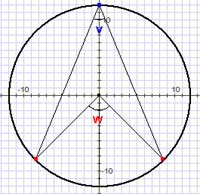4. Trigonometry
From Förberedande kurs i matematik 1
| Line 9: | Line 9: | ||
|} | |} | ||
| - | ''' | + | '''When did people first start studying geometry? When did people start using trigonometry to solve geometrical problems?''' |
| - | ''Watch the video in which the lecturer Lasse Svensson tells us | + | ''Watch the video in which the lecturer Lasse Svensson tells us about the origins of geometry and trigonometry.'' |
Revision as of 14:42, 10 November 2008
| \displaystyle \text{@(a class="image" href="http://smaug.nti.se/temp/KTH/film5.html" target="_blank")@(img src="http://wiki.math.se/wikis/2008/forberedandematte1/img_auth.php/0/00/Lars_och_Elin.jpg" alt="Film om trigonometri")@(/img)@(/a)} |
When did people first start studying geometry? When did people start using trigonometry to solve geometrical problems?
Watch the video in which the lecturer Lasse Svensson tells us about the origins of geometry and trigonometry.
What is geometry?
Geometry is a very old science. Geometry comes from Greek and means ”science of space”. "Ge" stands for earth and "metry" for science of measuring. Long before the birth of Jesus brilliant mathematicians had developed geometry.
Perhaps the most famous of these is EUCLID (around 300 BCE). He wrote a famous work entitled ELEMENTS - in which he summed up the mathematical knowledge of his time. In the 17th century one began to call into question some of the so-called Euclid AXIOMS and a NON-EUCLIDEAN geometry was developed which became of great importance in different contexts.
Trigonometry comes from Greek ("trigonon" stands for "triangle" and "metron" stands for "measure") and is a method to calculate the angles and sides of right-angled triangles. Trigonometry developed a few hundred years before the birth of Christ. One of the most famous mathematicians was HIPPARCHUS, who worked with the circle and chords within a circle. For each chord, he was able to calculate the corresponding arc length and in this way, he was able to determine the sides and angles of triangles. All this took place 2200 years before the advent of the calculator!
In this chapter we will see some examples of how geometric objects such as lines, parabolas and circles are described by equations. Similarly various regions can be described by inequalities.
The unit circle is of particular importance
The circle with a radius of 1 around the origin is especially important. One can use this circle to introduce the various concepts regarding angles as well as the trigonometric functions cosine and sine.
An angle corresponds to a point on the unit circle, the measure of the angle is the distance along the circle to the point (1.0), the cosine of the angle is the "x"-component of the point, the sine of the angle is "y"-component of the point.
The functions cosine and sine thus are used to translate from angles to distances.
If one is accustomed to think of cosine and sine as relations between the sides of a right-angled triangle, it is extremely important to rethink these functions in terms of the unit circle. This way it will be easier to understand trigonometric relationships like periodicity and the Pythagorean identity, the relationships for doubling angles and the formulas for derivatives.
To be able to manage and manipulate trigonometric expressions is important in most applications of mathematics. Thus the final section provides a thorough exercise to practise these skills.
Once geometry was one of the main elements in a mathematics course. In recent decades, classical geometry has decreased both in high school as well as in university's courses. But, for anyone who intends to be active in photography or graphics or with construction and design (such as CAD), a good knowledge of geometry is very valuable.
A knowledge of geometry is also very useful in everyday life, where one is often faced with questions of a geometrical nature.
It is important to note that the material in this section— as well as in other parts of the course — is designed that one does not use calculators.
To do well in Trigonometry
- Start by reading the section's theory and study the examples.
- Work through the exercises and try to solve them without using a calculator. Make sure that you have the right answer by clicking on the answer button. If you do not have it, you can click on the solution button to see what went wrong
- Then go ahead and answer the questions in the basic test of the section.
- If you get stuck on a point, check to see if someone else has discussed the point in the forum belonging to the section. If not, take up the point yourself. Your teacher (or a student) will respond to your question within a few hours.
- When you have answered correctly all questions in both the basic and the final test of this section you will have a pass for this section and then you should move on to Part 5 and work with an individual assignment and group assignment. Links to these are to be found in the "Student Lounge."
PS. If you feel that you are very familiar with the contents of a section you can test yourself by going directly to the basic and final tests. You must answer all the questions correctly in a test, but you may do the test several times if you do not succeed at the first attempt. It is your final results which appear in the statistics.

